This is the second part of the introduction to the history of the table.
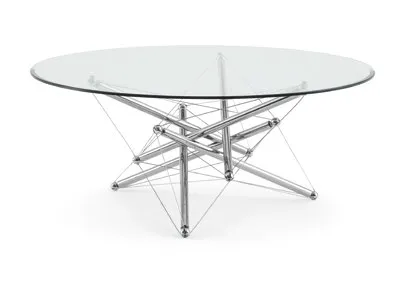
Dining table 714, Cassina, 1973
Design Theodore Waddel
The table originates from a 1956 research by Waddel with the objective to design extremely light and dynamic tables, based on the architecture of stretch tents. For Cassina, in 1972, he came up with a configuration that allowed for the creation of furniture pieces using support cables. The layout consists in six legs, of which three are suspended - supporting the glass top - with the remaining three standing on the ground but detached from the top.
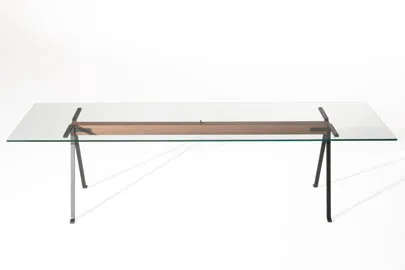
Frate, Driade, 1974
Design Enzo Mari
Designed in 1973 and produced from 1974 by Driade. With Frate, and the entire collection connected to it, Enzo Mari enhances the barren essentiality of the metal profile legs with a transparent, crystal tabletop. The secret of this table's success is the bold pairing of such different materials and the perfect balance between them.
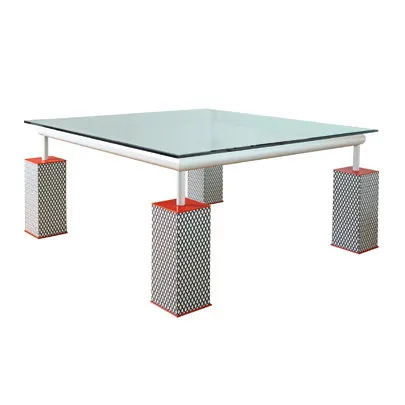
Mandarin, Memphis Milano, 1981
Design Ettore Sottsass
A metal table with wooden legs, plated with decorative laminate and a glass top, designed by Ettore Sotsass, the iconic Italian architect designer and photographer. In 1880 he co-founded the Memphis Group, with the intent to go beyond the accepted aesthetics of the industrial design of the time.
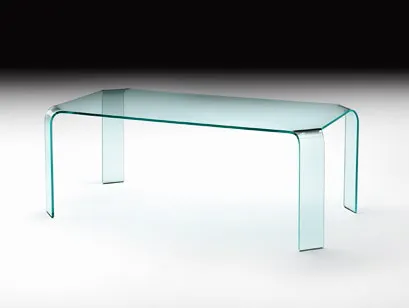
Ragno, Fiam, 1984
Design Vittorio Livi
Ragno is the first 15 mm bent-glass monolith table in the history of furniture. This particular material makes the sight of this table quite an experience, with the feeling of an empty room wherever it is placed. Almost invisible to the eye, yet very functional when used. The legs are placed diagonally, leaving ample room underneath the table for better usability.
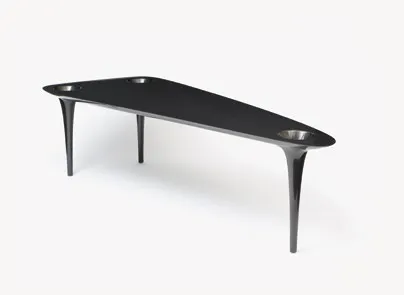
Black Hole, 1988
Design Marc Newson
The Black Hole directly addresses Marc's abiding interest in outer space, and inner too. The partially hollow legs of each table, like funnels, are conceptual renderings of black holes. The Idée edition was made by some Japanese surfboard makers Marc had met whilst living in Japan and who had experience of working with carbon fibre.
The Black Hole Table was carved out of polyurethane, then laminated with carbon fibre on the top and fiberglass on the bottom.
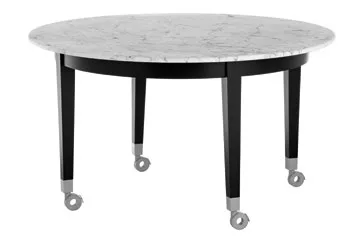
Neoz, Driade, 90s
Design Philippe Starck
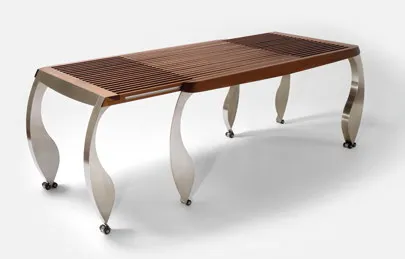
Split, Poltronova, 1990
Designed Ron Harad
The Split extendable table designed by Ron Arad in 1990 for Poltronova was one of the first items not self-produced by the English designer. Out of production for many years, it was reinserted in the catalogue in 2012, in the context of the program of reissued pieces of Centro Studi Poltronova. The top made with slats of various types of wood makes it possible to alter the size. It features elegant arched legs in brushes steel, giving the table an original sculptural dimension.
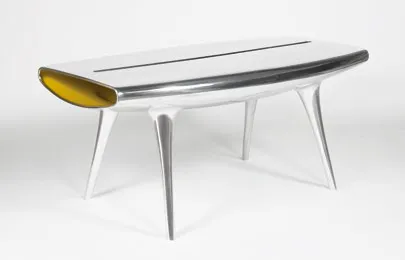
Event Horizon, 1992
Design Marc Newson
In the Event Horizon table, aluminum was worked as if it were a soft, pliable material, stretching and deforming seamlessly. Made by an Aston Martin restoration company near London, these coach-builders were highly skilled in welding, rubberising and forming and worked almost exclusively in aluminum. The table is made of spun aluminum, with four trumpet legs supporting a shaped top that, being open at both ends, reveals a hollow interior. The interior is coated with red “Ferrari” enamel.
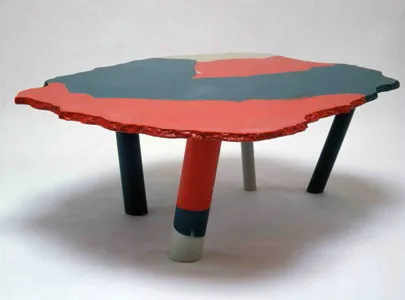
Sansone table, Gaetano Pesce, 1980
Design Gaetano Pesce
The Sansone table by Gaetano Pesce, one of the most prominent proponents of the so-called “radical” design, takes after the biblical tale of Samson and Dalila to describe the situation of the world at the end of the 20th Century. The legs remind of the temple's columns Samson knocked down in his extreme act of revenge. The message behind it is an open instigation to escape the established conventions regulating design.
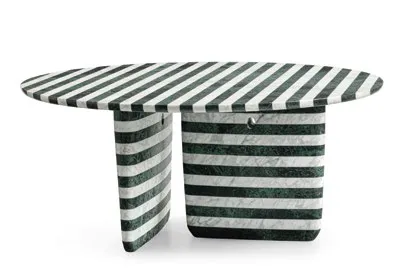
Tobi-Hihi, B&B Italia, 2012
Design Edward Barber & JayOsgerby
Available in two versions, round or rectangular-with-rounded-ends, Tobi-Hishi is a table that has a distinctive sculptural feel to it. The name itself alludes to the ornamental stones decorating Japanese gardens, which also serve as an inspiration for its structural elements. The elegant balance between robustness and lightness also marks the new special edition made with strips of white Carrara marble and requiring highly sophisticated craftsmanship in its entirely manual construction.
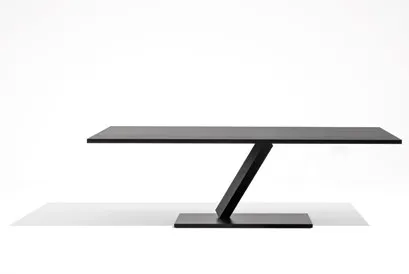
Element, Desaltom, 2013
Design Tokujin Yoshioka
An iconic table, Element is the emblem of purity and poetry, the hallmark of visionary designer Tokujn Yoshioka. The central stand, poised between the two horizontal elements, defies gravity, suspended as it is between earth and sky, between past and present. The black cement finish makes this perfect dynamic balance between lightness and sturdiness even more concrete.
It wasn't until the 15th Century that the table came in one single piece, with legs connected by sturdy bars at floor level. These fixed-dimensions objects were made of oak or elm wood, thus quite heavy to move around. In the 16th Century, a contraption was invented to increase their size, the very table-extensions we are still using today.
The Renaissance and its revival of classicism brought significant changes in style: inspired by the Roman and Greek tables, Renaissance tables gained sculpted, richly ornate legs with naturalistic motifs, while tops where embellished by paintings and ebony, ivory, marble and hard stones inlays.
But the fanciest tables certainly belong to Baroque, with the most elaborate colour effects. The craze for rich, opulent tables was at its peak, and was promoted by monarchies of the time wanting to imitate Louis XIV's Versailles. Up until the mid 17th Century they'd have silver-lined tables, with ebony and precious marble marquetry, made by the best craftsmen, often Italians. In the 18th Century, these precious materials were progressively supplanted by lacquering, in the wake of the growing commercial and cultural relations between the Western World and the Far East. During that period, alongside traditional dining tables, some specialised tables started to appear, specifically designed for coffee and tea, cards, or writing and reading. The trend persisted right up to the early 20th Century.
From a design point of view, for the second half of the 19th Century the mood would be to privilege simpler forms, a trend that was also dictated by the advent of mass production. Industrialisation would facilitate new building concepts by which the different parts of a table would come pre-formed and then assembled once sent to retailers.
The success of Art Nouveau, towards the end of the 1800's, would bring back a taste for classical forms and, most of all, significantly reduce the size and importance of the table. A trend rooted in the aspiration for greater order and space within the home.
In the course of the 20th Century the design of tables tended to follow the profound social and economical changes that marked the period. New technological solutions were devised and new materials adopted, such as plastic, metal, glass fibre and even corrugated cardboard. Traditional forms gave way to bolder solutions, characterised by the use of multiple colours. While maintaining its central function as a piece of furniture on which meals are served and consumed, the modern table also became the place where meetings and games took place, as happens today. In our contemporary societies, tables have even expanded this social role and have come to incarnate the essence of conviviality and art de vivre.
Copyright © Homa 2023
All rights reserved

.jpg?VGhlIFBlcmZlY3QgU2xvdC1pbijmraPnoa4pLmpwZw==)

































